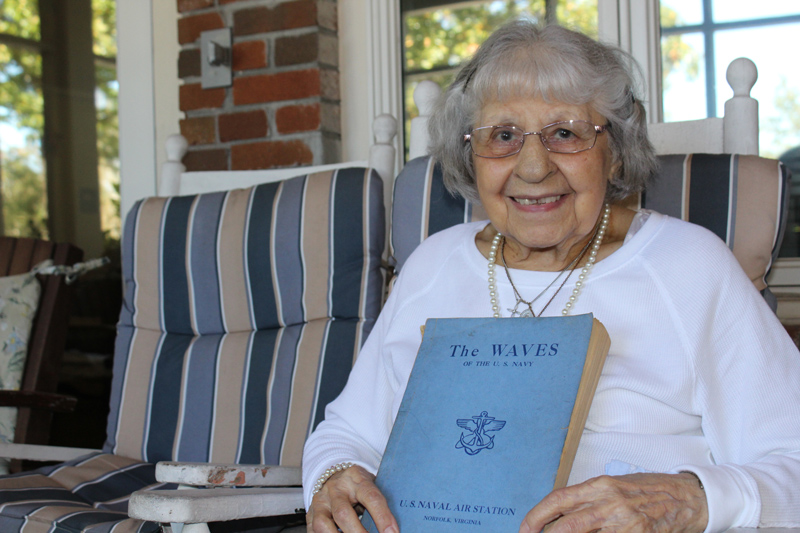
CHARLESTON—During the Depression, Mabel Caron’s family would pack picnic lunches and ride from Baltimore to nearby Annapolis to watch midshipmen at the U.S. Naval Academy march in formation.
Those simple weekend trips planted a dream in little Mabel’s heart. She wanted to be part of the U.S. Navy.
World War II gave her the chance. In 1943, she became one of the WAVES.
Also known as Women Accepted for Voluntary Emergency Service, it was a women’s branch of the U.S. Naval Reserve set up during the war. Women took over many shore duties at naval bases to free up men for service at sea.
Caron, 93, now lives at the Carter- May Home and looks back on those years as one of the happiest times of her life.
She proudly shows visitors a blue book from the era that tells the WAVES story. She appears in three photos singing with the WAVES chorus, posing with a fundraising sign and meeting movie star Walter Pidgeon (below).

“I always loved the U.S. Navy and was so proud I got to serve,” she said. “I’m so proud of the way we pitched in and the way women back then pitched in. It was a big opportunity for us and we helped a lot.”
Caron’s family eventually moved from Maryland to Lancaster in upstate South Carolina, where her father Waddell Francis worked in the textile mill and was one of the founding members of St. Catherine of Siena Church.
Even though she was hours from the ocean, her Navy dreams never left her.
Caron believes her love of the sea and ships was passed down from Lebanese ancestors. She recalls how the Lebanese were involved in ship-building as far back as Biblical times, and said her father took a job in a shipyard during World War I when he was turned down for naval service.
Her parents never guessed that their daughter’s love for the sea would take her far from home.
The WAVES program started in 1942. In the fall of that year she went to Charlotte, N.C., to enlist without telling her parents.
“When they found out a few days later, it was World War three!” she recalled with a mischievous giggle. “My parents didn’t want me to go. There were other members of the family who didn’t want to talk to me, who said I was disobeying my parents. But I didn’t care. I was going!”

A few weeks later, she left South Carolina for her first trip to New York City, where WAVES went through boot camp and training in converted space at Hunter College in the Bronx. She had to pass physical fitness training, learn basic military skills, and memorize the regulations in the famous “Bluejackets Manual” issued to all Navy personnel.
She originally wanted to be an air traffic controller, but was turned down because of her eyesight. Instead, she trained in communications and was stationed first at Sampson Naval Training Base in upstate New York and then the Naval Air Station at Breezy Point, Va., near Norfolk.
“I didn’t get to be an air traffic controller, but in a way I got my dream because I got to look at planes all day,” Caron said.
She returned to Hunter College for a second round of training to work in the Fleet Post Office. The era’s safety precautions made travel between the military installations interesting and sometimes scary.
“You were under blackout conditions wherever you went, so even the cars’ headlights were muffled,” she said. “And you had to have a pile of documents with you at all times proving who you were and where you were supposed to be. People were constantly worried about spies.”
She met eventual husband Paul Caron, also stationed in Norfolk, and the two married during the war.
The Fleet Post Office had a large glass window where workers could see ships coming and going, and Caron remembers seeing the battleship USS Missouri return to port after the Japanese signed surrender documents on her deck. The ship’s return was joyful but also signaled the end of the war and her Navy career.
“I missed it, especially the camaraderie we all had, but life changes,” she said. “The children started coming.”
Paul and Mabel moved back to Lancaster, where they both took jobs and raised seven children. Today, Mrs. Caron also has 18 grandchildren and four great-grands.
Her son in Florida gathered her WAVES memorabilia and a replica uniform and displays it there. She lost touch over the years with the other women who served with her.
She talks about her service with anyone who is interested, and especially treasures the recent memory of an ambulance driver who took her to a Charleston hospital for heart surgery earlier this year. When he learned about her service, he said he had never met a woman who served in World War II. He thanked her, with tears in his eyes.
Top photo — Miscellany/Christina Lee Knauss: Mabel Caron holds a book about WAVES, a women’s branch of the U.S. Naval Reserve, of which she was a proud member.

